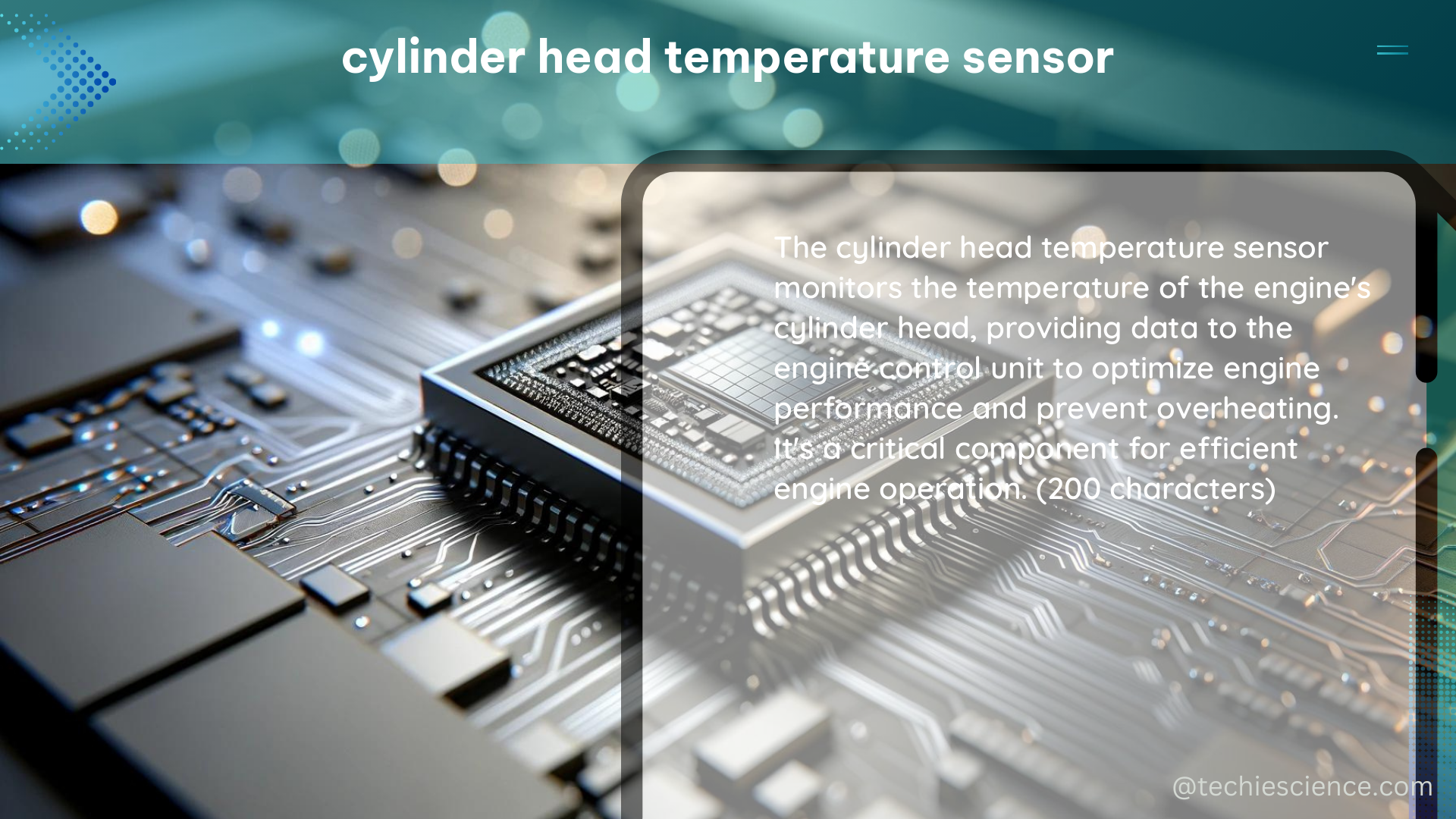The cylinder head temperature sensor is a crucial component in the engine management system of modern vehicles. It measures the temperature of the cylinder head, which is a critical parameter for controlling engine performance, fuel efficiency, and emissions. The sensor typically consists of a thermistor or a resistance temperature detector (RTD) that changes resistance with temperature. The resistance is measured and converted to a temperature reading by the engine control unit (ECU).
Technical Specifications of Cylinder Head Temperature Sensor
The technical specifications of a typical cylinder head temperature sensor may include the following:
| Specification | Value |
|---|---|
| Temperature Range | -40°C to 1250°C (-40°F to 2282°F) |
| Accuracy | ±2°C (±3.6°F) from -40°C to 125°C (±40°F to 257°F) |
| Response Time | 10 seconds or less |
| Operating Voltage | 4.5V to 5.5V |
| Operating Current | 5mA or less |
| Insulation Resistance | 1000MΩ or more |
| Temperature Coefficient of Resistance | -0.385%/°C or more |
| Thermal Resistance | 1000K/W or less |
| Package Size | 6mm diameter x 25mm length (0.24″ diameter x 0.98″ length) |
These specifications ensure that the cylinder head temperature sensor can accurately measure the temperature range encountered in modern engines, with a fast response time and low power consumption.
Sensor Installation Considerations

Installing a cylinder head temperature sensor requires careful consideration of the sensor’s location and orientation. The sensor should be located in a position that provides a representative measurement of the cylinder head temperature, away from sources of heat or cooling that may affect the reading. The sensor should be securely mounted to prevent movement or damage, and the leads should be routed away from sources of interference or damage.
To ensure accurate and reliable measurements, the sensor should be installed in a location that is representative of the overall cylinder head temperature. This may involve positioning the sensor near the center of the cylinder head, or in a location that is exposed to the highest temperatures during engine operation. The sensor should also be oriented in a way that minimizes the impact of airflow or other environmental factors on the temperature reading.
Measuring Cylinder Head Temperature
Measuring the cylinder head temperature involves connecting the sensor to a temperature measuring instrument or data acquisition system. The sensor resistance is measured and converted to a temperature reading using the sensor’s calibration data. The measurement accuracy and resolution depend on the sensor specifications and the measurement instrument or system.
To measure the cylinder head temperature, the sensor is typically connected to the engine control unit (ECU) or a separate data acquisition system. The ECU or data acquisition system will measure the resistance of the sensor and use a calibration curve or equation to convert the resistance to a temperature value. The temperature data can then be used by the engine management system to optimize engine performance, fuel efficiency, and emissions.
The accuracy and resolution of the temperature measurement will depend on factors such as the sensor’s temperature range, accuracy, and response time, as well as the quality and calibration of the measurement instrument or system. High-precision temperature measurement systems may use advanced techniques such as digital signal processing or neural network-based algorithms to improve the accuracy and reliability of the temperature readings.
Sensor Diagnostics and Troubleshooting
In addition to the sensor’s technical specifications and installation requirements, it is important to consider the diagnostic and troubleshooting capabilities of the cylinder head temperature sensor. The sensor should be designed to provide reliable and consistent temperature readings, and to detect and report any faults or failures that may occur.
Some common diagnostic features of cylinder head temperature sensors include:
- Resistance measurement: The sensor’s resistance can be measured to verify that it is within the expected range for the current temperature.
- Voltage output: The sensor’s voltage output can be measured to ensure that it is within the expected range for the current temperature.
- Fault detection: The sensor should be able to detect and report any faults or failures, such as open circuits, short circuits, or out-of-range temperature readings.
- Diagnostic trouble codes: The sensor should be able to generate diagnostic trouble codes that can be read by the engine management system or a diagnostic tool, to help identify and troubleshoot any issues.
By understanding the diagnostic and troubleshooting capabilities of the cylinder head temperature sensor, technicians can more effectively diagnose and repair any issues that may arise with the engine management system.
Conclusion
The cylinder head temperature sensor is a critical component in the engine management system of modern vehicles. Its technical specifications, installation requirements, and diagnostic capabilities are all important factors to consider when working with this sensor. By understanding the details of the cylinder head temperature sensor, technicians can ensure that it is installed and functioning correctly, and can more effectively diagnose and repair any issues that may arise with the engine management system.
References:
- Guidelines for Sampling, North Carolina Department of Environmental Quality, March 7, 2022.
- Temperature Measurement and Control Catalog, Lake Shore Cryotronics, Inc., 2022.
- Maintenance Performance Measurement and Management, Division of Vehicle and Traffic Safety, Luleå University of Technology, 2018.
- What Is The In Cylinder IAT Drop With e85?, Modular Fords Forum, July 2, 2013.
- Federal Motor Vehicle Safety Standards; Rear Visibility, Federal Register, April 7, 2014.

The lambdageeks.com Core SME Team is a group of experienced subject matter experts from diverse scientific and technical fields including Physics, Chemistry, Technology,Electronics & Electrical Engineering, Automotive, Mechanical Engineering. Our team collaborates to create high-quality, well-researched articles on a wide range of science and technology topics for the lambdageeks.com website.
All Our Senior SME are having more than 7 Years of experience in the respective fields . They are either Working Industry Professionals or assocaited With different Universities. Refer Our Authors Page to get to know About our Core SMEs.